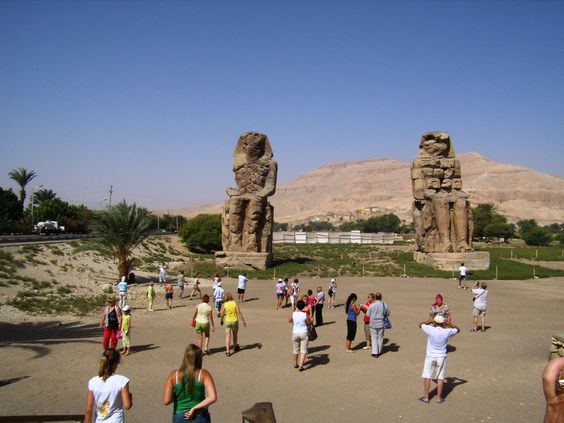The Colossi of Memnon stand proudly on the west bank of the Nile River near Luxor, Egypt, serving as silent sentinels that have witnessed over 3,400 years of history. These imposing statues, made from massive blocks of quartzite, are a testament to the grandeur of ancient Egyptian civilization. In this article, we will delve into the history, significance, and the enduring mystique surrounding the Colossi of Memnon.
Historical Background

Built during the 14th century BCE by the pharaoh Amenhotep III, the Colossi of Memnon were part of the pharaoh’s grand mortuary temple, which was one of the largest and most opulent structures in ancient Thebes. Originally, the temple complex included two colossal statues, each depicting Amenhotep III seated on his throne with hands resting on his knees, a symbol of his authority and stability.
The Name "Memnon"
The name “Memnon” is derived from the ancient Greek mythology, where Memnon was a hero and king of Ethiopia, who fought in the Trojan War. The Greeks associated the statues with the legendary Memnon due to the mysterious sound that one of the statues emitted during the Roman period.
The Mysterious Sound
One of the most intriguing aspects of the Colossi of Memnon is the phenomenon of a mysterious sound that emanated from one of the statues during the morning hours. Ancient records report that around sunrise, the northern colossus would produce a melodious sound, which the Greeks believed to be the voice of Memnon mourning for his mother Eos, the goddess of dawn. This phenomenon ceased in 199 AD after an earthquake damaged the statue.
Architectural Details
Standing at approximately 18 meters (60 feet) in height, the Colossi of Memnon showcase the mastery of ancient Egyptian craftsmanship. Carved from a single piece of quartzite, each statue weighs an estimated 720 tons. The level of detail in the facial features, headdress, and royal regalia is indicative of the skilled artisans of the time.

Archaeological Discoveries

Throughout the centuries, the Colossi of Memnon have undergone various restoration and conservation efforts. Archaeologists have unearthed remnants of Amenhotep III’s mortuary temple, shedding light on the grandeur that once surrounded the colossal statues. Excavations have also revealed the presence of statues representing the pharaoh’s wife, Queen Tiye, as well as intricate reliefs depicting religious ceremonies.
Significance and Legacy
The Colossi of Memnon remain symbolic representations of the power and might of ancient Egypt. Despite the ravages of time, these colossal statues continue to captivate the imagination of visitors from around the world, drawing them into the allure of a civilization that left an indelible mark on human history.

Conclusion
The Colossi of Memnon stand as resilient witnesses to the passage of time, silently narrating the tales of ancient Egyptian splendor. From their association with Amenhotep III to the mysterious sounds that once echoed across the Nile, these colossal statues invite us to explore the rich tapestry of Egypt’s past. As guardians of ancient Thebes, the Colossi of Memnon stand tall, reminding us of the enduring legacy of a civilization that thrived along the banks of the Nile.
Blockquote
Seated in regal splendor, I, Amenhotep III, commissioned these monumental guardians to watch over my mortuary temple, a testament to the divine authority bestowed upon me by the gods. Their colossal presence, hands resting on knees, symbolizes the stability and strength that characterized my rule over the Two Lands.
Amenhotep III, Pharaoh of the Eighteenth Dynasty




